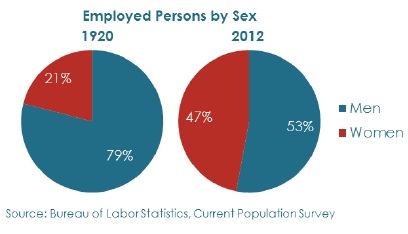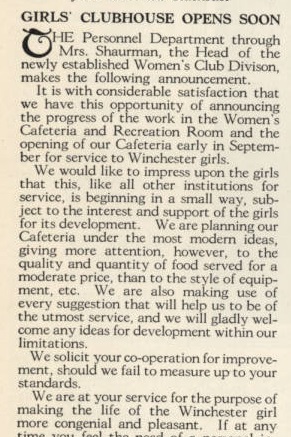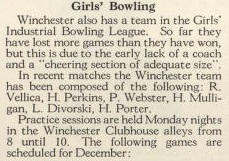Impact of World War I on women in the workplace
In 1917 the U.S. joined World War I. A year later the first issue of the Winchester Record was published. This was published twice a month by the Winchester Personnel Department until 1921. The McCracken Library has all 63 of these publications. Among the articles on how to sell Winchester products, is a glimpse into what it was like to work for The Winchester Repeating Arms Company. It’s quickly apparent that Winchester treated it’s employees, especially the women, differently than other companies of the time. They offered benefits such as their own clubhouse and sports teams as well as recognition in the work place.
The first World War saw women enter the workforce in large numbers to take jobs men left vacant. During this time the percentage of women in the workforce increased. However, when the war ended in 1919, the returning soldiers went to work and took back their jobs leaving many women unemployed. This chart from the 1920 Department of Labor, Women’s Bureau shows the changes in employment at the end of World War I.
Many women were happy to leave their jobs and go back to their home life, but many of them wanted to continue to be employed. These women were left with only a handful of job options: school teachers, nurses, secretaries, housekeepers, and factory workers. These limited options are reflected in this chart from the United States Department of Labor.
Winchester to the rescue!
The Winchester Repeating Arms Company stood out as a company that actively sought good employees in a variety of positions. They frequently advertised jobs for women and promised good benefits as this page from the May 1920 issue of the Winchester Record shows.
Winchester followed through with its promises made in this ad and built a clubhouse for its female employees which it announced in the September 1920 issue of the Record.
Working conditions for women
This was in stark contrast to the norm of the day. Working conditions for many women were dismal. History is littered with stories of companies treating their women employees poorly. The Ohio History Connection talks about these conditions, “factories were not heated or air-conditioned. Most of the factories also lacked sufficient light and ventilation. Women routinely worked in these conditions for twelve to fourteen hours per day, six days per week. If a woman was injured on the job, her employer provided her with no workers’ compensation or health care benefits. Most employers simply fired the injured worker.”
The Winchester company not only improved working conditions, it honored its employee’s accomplishments. It frequently published articles highlighting the success of rifle-women and the awards they received as in this early Winchester Record publication of 1918:
Benefits of working for Winchester
Winchester rewarded all employees, women included, with honors for long term employment as illustrated in Volume 1, Number 14. Here Miss Foley has praises heaped upon her for her years of faithful service.
Winchester not only trained their employees well, but was dedicated to providing activities outside of work and established sports teams for its employees with women’s basketball and bowling teams as reported in 1920:
They believed in the improvement of its employees not only at work, but in life and offered classes for women and girls such as these listed in the November 1920 issue:
Most importantly Winchester saw the benefit of having female leaders and promoted women to leadership roles within the company reported in Volume 2, Number 18, page 7:
The Winchester Company was able to see the advantage of hiring Millicent Pond because of her abilities and qualifications and promoted her to a position where she could profit the company. Truly Miss Pond was a pioneer and example for women shown by her educational and employment accomplishments.
The Winchester Record is an enlightening look at working conditions in the early 1900s. It must have been a haven of encouragement and respect rarely found at this time in history. Overall the Winchester Repeating Arms Company provided a good work place for all, including women, and was quick to recognize their contributions. Bravo Winchester!
References
Adams, J.H.J. (Ed.). (1918, December 20). Frances Collins. Winchester Record, 1(10), 14, retrieved from http://library.centerofthewest.org/cdm/compoundobject/collection/FP/id/173/rec/39.
Adams, J.H.J. (Ed.). (1919, February 14). Mary Foley. Winchester Record, 1(14), 9, retrieved from http://library.centerofthewest.org/cdm/compoundobject/collection/FP/id/259/rec/52.
Moore, R.D. (Ed.). (1920, April 9). Millicent Pond. Winchester Record, 2(18), 7, retrieved from http://library.centerofthewest.org/cdm/compoundobject/collection/FP/id/998/rec/49.
Moore, R. D. (Ed.). (1920, May 7). Pick the right job and stick to it! Winchester Record, 2(20), 14, retrieved from http://library.centerofthewest.org/cdm/compoundobject/collection/FP/id/1036/rec/10
Moore, R. D. (Ed.). (1920, September 10). Girls clubhouse opens soon. Winchester Record, 3(3), 2, retrieved from http://library.centerofthewest.org/cdm/compoundobject/collection/FP/id/1112/rec/3.
Moore, R.D. (Ed.). (1920, November 19). How about it, girls? Winchester Record, 3(8), 10, retrieved from http://library.centerofthewest.org/cdm/compoundobject/collection/FP/id/1197/rec/24.
Moore, R.D. (Ed.). (1920, December 3). Girls’ bowling. Winchester Record, 3(9), 5, retrieved from http://library.centerofthewest.org/cdm/compoundobject/collection/FP/id/1214/rec/9.
Moore, R.D. (Ed.). (1920, December 3). Winchester girls open basket ball season. Winchester Record, 3(9), 5, retrieved from http://library.centerofthewest.org/cdm/compoundobject/collection/FP/id/1214/rec/9.
Ohio History Connection. (2018). Women in the industrial workforce. Retrieved from http://www.ohiohistorycentral.org/w/Women_in_the_Industrial_Workforce.
United States Department of Labor. (n.d.). Working women today. Retrieved from https://www.dol.gov/wb/overview_14.htm.
U.S. Department of Labor. (1920). The new position of women in American industry. Bulletin of the Women’s Bureau, (12), 92. Washington D.C.: Government printing office. Retrieved from https://books.google.com.















